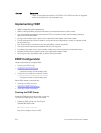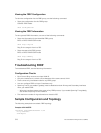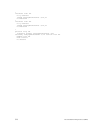Concept Explanation
Control VLAN Each ring has a unique Control VLAN through which tagged ring health frames
(RHF) are sent. Control VLANs are used only for sending RHF, and cannot be used
for any other purpose.
Member VLAN Each ring maintains a list of member VLANs. Member VLANs must be consistent
across the entire ring.
Port Role Each node has two ports for each ring: Primary and Secondary. The Master node
Primary port generates RHFs. The Master node Secondary port receives the RHFs.
On Transit nodes, there is no distinction between a Primary and Secondary
interface when operating in the Normal state.
Ring Interface
State
Each interface (port) that is part of the ring maintains one of four states”
• Blocking State — Accepts ring protocol packets but blocks data packets. LLDP,
FEFD, or other Layer 2 control packets are accepted. Only the Master node
Secondary port can enter this state.
• Pre-Forwarding State — A transition state before moving to the Forward state.
Control traffic is forwarded but data traffic is blocked. The Master node
Secondary port transitions through this state during ring bring-up. All ports
transition through this state when a port comes up.
• Pre-Forwarding State — A transition state before moving to the Forward state.
Control traffic is forwarded but data traffic is blocked. The Master node
Secondary port transitions through this state during ring bring-up. All ports
transition through this state when a port comes up.
• Disabled State — When the port is disabled or down, or is not on the VLAN.
Ring Protocol
Timers
• Hello Interval — The interval when ring frames are generated from the Master
node’s Primary interface (default 500 ms). The Hello interval is configurable in
50 ms increments from 50 ms to 2000 ms.
• Dead Interval — The interval when data traffic is blocked on a port. The default
is three times the Hello interval rate. The dead interval is configurable in 50 ms
increments from 50 ms to 6000 ms.
Ring Status The state of the FRRP ring. During initialization/configuration, the default ring
status is Ring-down (disabled). The Primary and Secondary interfaces, control
VLAN, and Master and Transit node information must be configured for the ring to
be up.
• Ring-Up — Ring is up and operational.
• Ring-Down — Ring is broken or not set up.
Ring Health-Check
Frame (RHF)
The Master node generates two types of RHFs. RHFs never loop the ring because
they terminate at the Master node’s secondary port.
• Hello RHF (HRHF) — These frames are processed only on the Master node’s
Secondary port. The Transit nodes pass the HRHF through without processing
it. An HRHF is sent at every Hello interval.
• Topology Change RHF (TCRHF) — These frames contains ring status, keepalive,
and the control and member VLAN hash. The TCRHF is processed at each node
of the ring. TCRHFs are sent out the Master Node’s Primary and Secondary
interface when the ring is declared in a Failed state with the same sequence
number, on any topology change to ensure that all Transit nodes receive it.
Force10 Resilient Ring Protocol (FRRP)
371


















